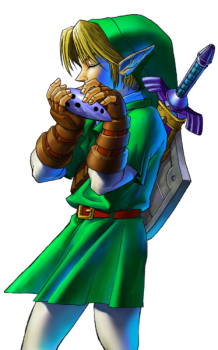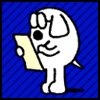From the Ocarina to the Harp: Instruments in 3D Zelda Games
Posted on April 20 2012 by Hanyou
 One of the standout achievements of Ocarina of Time is that it took the concept of an instrument as an item — previously seen in the 2D Zelda games, starting with the very first — and expanded on it in the most creative ways available. Previously, instruments in the Zelda series had had limited utility. The Legend of Zelda’s Recorder acted strictly as a warp item. A Link to the Past’s Flute built on that idea by giving the item a backstory, but essentially did the very same thing.
One of the standout achievements of Ocarina of Time is that it took the concept of an instrument as an item — previously seen in the 2D Zelda games, starting with the very first — and expanded on it in the most creative ways available. Previously, instruments in the Zelda series had had limited utility. The Legend of Zelda’s Recorder acted strictly as a warp item. A Link to the Past’s Flute built on that idea by giving the item a backstory, but essentially did the very same thing.
Link’s Awakening was the first Zelda game to hint at the potential for a musical item. Link learned three songs for his Ocarina, each with a different use. Music was central to the game and drove Link’s interactions with characters like Marin. Instruments also propelled Link through the dungeons and to the end credits. The Ocarina was one of Link’s Awakening’s more memorable items, but it didn’t showcase its full potential — at least, not yet.
In Ocarina of Time, the Ocarina was not only consistently used to solve puzzles and warp, but to perform a variety of other actions. Even more importantly, the Ocarina was cinematic. As in Link’s Awakening, music was a central theme to Ocarina of Time; what was surprising was how diverse its uses were, and how consistently exciting it could be. The Ocarina served as a key to Darunia’s throne room, and also to the Door of Time that separated Link from his most pivotal adventures and the game’s most epic moments. It drained the well in Kakariko village, unearthing Hyrule’s darkest secrets.
 The Ocarina also had the virtue of repetition. Who can forget playing Zelda’s lullaby every time the Triforce symbol was prominently displayed (especially in the Water Temple), or playing the song of time to move blocks and access new areas?
The Ocarina also had the virtue of repetition. Who can forget playing Zelda’s lullaby every time the Triforce symbol was prominently displayed (especially in the Water Temple), or playing the song of time to move blocks and access new areas?
Most importantly, it added a personal element to the gameplay experience that might otherwise have been missing. The Ocarina wasn’t just another item — it felt like a full-fledged, legitimate instrument, and it felt like an extension of the player. In 1998, Zelda didn’t offer 1:1 swordplay. The game was made up of button presses, and there was, as with any game, a constant separation between the player and the character on the screen. However much of a “link” to the player our hero in green is supposed to be, you never are really Link.
But the Ocarina was different. With its clear notes and intuitive configuration, every button press connected the player directly to the game, if only for a fleeting instant. The Ocarina was possibly the most important way the Hero of Time interacted with Hyrule, and it was at your fingertips. You didn’t push one button to warp to the Forest Temple or call on Epona; you worked your way there.
It was a brilliant mechanic, and if the designers didn’t know quite how good it was, it’s not in the least bit evident in the final product. The Ocarina is exploited to the fullest extent possible. Again, every button is intuitively arranged so it’s easy to memorize and play the key songs in the game, but there’s also a level of customization that makes the Ocarina even more personalized. By tilting the control stick and spending time learning the instrument, you can play it in earnest and do neat, nonessential tricks. One Scarecrow encouraged such wild experimentation by allowing the player to record an Ocarina song without boundaries; another allowed the player to make his imprint on the world by composing a legitimate Ocarina song to be used alongside the others.
 By the end of the game, there were probably few players who hadn’t spent some time trying to figure out what the Ocarina was capable of.
By the end of the game, there were probably few players who hadn’t spent some time trying to figure out what the Ocarina was capable of.
Majora’s Mask built on the ideas presented in Ocarina of Time. We already knew what to expect, and the basics stayed the same. However, the songs did an even wider variety of things, and the different instruments for the Deku, Zora, and Goron at least added an interesting superficial element, used to great effect in a Milk Bar minigame.
Like Ocarina of Time, The Wind Waker is named after its chief instrument. This may be a bit deceptive, as the nominal instrument didn’t feel as important in The Wind Waker as it did in Ocarina of Time. The Wind Waker was a fun experiment. The item fit the game’s theme as perfectly as the Ocarina had fit its previous two games, and the basic mechanic was fresh. Of course, something was missing; experimentation was no longer very lucrative and the game didn’t encourage it very much. As opposed to the consistently pleasant tone of the Ocarina, the crude choir sounded odd, and learning more complex songs was often frustrating. While the Wind Waker was by no means a bad instrument, it was arguably a step down — one that might have been just fine if it had been isolated to one game. The key is, of course, that it still managed to fit in, and little was sacrificed in the process.
Unfortunately, every Zelda game since then (excepting The Minish Cap, which simply uses the Wind Ocarina as instruments were used in previous 2D titles) has offered a less interesting instrument. Wolf Link’s howling barely counts; it was an even more frustrating version of The Wind Waker used sparsely throughout the game. Twilight Princess, fortunately, did not use or advertise music as a central feature, so none of the deficiencies — including the grass used to call Epona — can really be counted against the game very much. The Spirit Flute might have been as good as the Ocarina, but blowing into the mic made it difficult to play. As with Twilight Princess, it didn’t seem to play much of a central role; in this case, it seemed entirely misplaced in the game, as if it was there to meet a quota and then treated as an afterthought.
Skyward Sword, however, presents an interesting case. The harp has a backstory — to gamers who have played Ocarina of Time, the opportunity to use Sheik’s harp should be exciting. Furthermore, the harp is an entirely different type of instrument, as novel as the conductor’s baton in The Wind Waker. The real instrument has a level of complexity that leaves it open to boundless gameplay ideas. It’s also worth noting that Skyward Sword is the first Zelda game with an orchestrated soundtrack. That’s something Zelda gamers have been clamoring for for some time, and one would expect Nintendo to make good use of the instrument.
Music once again plays a central role in Skyward Sword, and doesn’t feel shoehorned in. An entire island is dedicated to learning songs, and meetings with the three dragons at the end of the game are all engineered around the music. The harp is permanently set to a prominent button on the Wii remote, and telltale butterflies signal an opportunity to use it. In other words, it’s set up to be a big deal.
However, the harp is a disappointment. Playing the harp in Skyward Sword is insultingly easy and hardly engaging; it required no real input from the player except, well, waggling. Swinging the Wii remote back and forth is all it takes to play any song, and songs can only be played at specified times; at all other times, using the harp sounds like noodling without any technical proficiency. It is purely impersonal, another item to open up new sections of the game but nothing more.
Perhaps implementing button-presses instead of Wii remote waggling would have been the way to go. Even allowing the player to pluck strings by hovering over them with the Wii remote, then pressing a button, would have at least been engaging.
But there’s something more at work here than the simple gameplay mechanic. In Ocarina of Time, the Ocarina was a symbol of freedom, emphasizing player input and customization. As Zelda games have gotten more linear, so have the instruments. Once again, when the instrument is not a central gameplay element, this is not a huge issue, nor should every Zelda game require an instrument. But when music is important, it’s disappointing to see a series which once featured such a creative mechanic reduce the musical instrument, once again, to no more than another item.
What is especially jarring about the harp is that most of Skyward Sword’s items are well-developed. Skyward Sword is a game based on direct player input, on making the player connect with Link’s world like never before. In many ways, it’s successful in its mission. It also features a stunning soundtrack which would make participation fun.
In the future, it would serve Nintendo well to either reduce the role of the musical instruments to their use in the 2D games as just another item, or to expand on it. At the very least, it would be fun to see another Ocarina of Time, where the instrument feels real and offers a point of connection between the player and Hyrule. The potential is certainly there, and the developers have shown a willingness to connect us directly with Hyrule. With new technology and the new ideas that naturally come with every Zelda game, a musical instrument with multiple uses would certainly be welcome.





